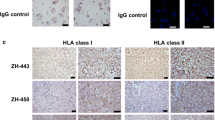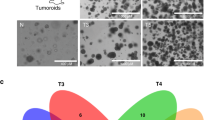Abstract
Recent studies have revealed that treatment-resistant cancer stem-like cells (CSCs)/cancer-initiating cells (CICs) can be targeted by cytotoxic T lymphocytes (CTLs). CTLs recognize antigenic peptides derived from tumor-associated antigens; thus, the identification of tumor-associated antigens expressed by CSCs/CICs is essential. Human leucocyte antigen (HLA) ligandome analysis using mass spectrometry enables the analysis of naturally expressed antigenic peptides; however, HLA ligandome analysis requires a large number of cells and is challenging for CSCs/CICs. In this study, we established a novel bladder CSC/CIC model from a bladder cancer cell line (UM-UC-3 cells) using an ALDEFLUOR assay. CSCs/CICs were isolated as aldehyde dehydrogenase (ALDH)-high cells and several ALDHhigh clone cells were established. ALDHhigh clone cells were enriched with CSCs/CICs by sphere formation and tumorigenicity in immunodeficient mice. HLA ligandome analysis and cap analysis of gene expression using ALDHhigh clone cells revealed a distinctive antigenic peptide repertoire in bladder CSCs/CICs, and we found that a glutamate receptor, ionotropic, kainite 2 (GRIK2)-derived antigenic peptide (LMYDAVHVV) was specifically expressed by CSCs/CICs. A GRIK2 peptide-specific CTL clone recognized GRIK2-overexpressing UM-UC-3 cells and ALDHhigh clone cells, indicating that GRIK2 peptide can be a novel target for bladder CSC/CIC-targeting immunotherapy.





Similar content being viewed by others
References
Siegel RL, Miller KD, Jemal A (2020) Cancer statistics, 2020. CA Cancer J Clin 70:7–30
Kamat AM, Hahn NM, Efstathiou JA et al (2016) Bladder cancer. Lancet 388:2796–2810
Advanced Bladder Cancer (ABC) Meta-analysis Collaboration (2005) Adjuvant chemotherapy in invasive bladder cancer: a systematic review and meta-analysis of individual patient data Advanced Bladder Cancer (ABC) Meta-analysis Collaboration. Eur Urol 48:189–199. Discussion 199–201
International Collaboration of Trialists, Medical Research Council Advanced Bladder Cancer Working Party (now the National Cancer Research Institute Bladder Cancer Clinical Studies Group), European Organisation for Research and Treatment of Cancer Genito-Urinary Tract Cancer Group et al. (2011) International phase III trial assessing neoadjuvant cisplatin, methotrexate, and vinblastine chemotherapy for muscle-invasive bladder cancer: long-term results of the BA06 30894 trial. J Clin Oncol 29:2171–2177
Patel VG, Oh WK, Galsky MD (2020) Treatment of muscle-invasive and advanced bladder cancer in 2020. CA Cancer J Clin 70:404–423
Clevers H (2011) The cancer stem cell: premises, promises and challenges. Nat Med 17:313–319
Park CY, Tseng D, Weissman IL (2009) Cancer stem cell-directed therapies: recent data from the laboratory and clinic. Mol Ther 17:219–230
Hirohashi Y, Torigoe T, Tsukahara T et al (2016) Immune responses to human cancer stem-like cells/cancer-initiating cells. Cancer Sci 107:12–17
Nishizawa S, Hirohashi Y, Torigoe T et al (2012) HSP DNAJB8 controls tumor-initiating ability in renal cancer stem-like cells. Cancer Res 72:2844–2854
Morita R, Hirohashi Y, Torigoe T et al (2016) Olfactory receptor family 7 subfamily C member 1 is a novel marker of colon cancer-initiating cells and is a potent target of immunotherapy. Clin Cancer Res 22:3298–3309
Asano T, Hirohashi Y, Torigoe T et al (2016) Brother of the regulator of the imprinted site (BORIS) variant subfamily 6 is involved in cervical cancer stemness and can be a target of immunotherapy. Oncotarget 7:11223–11237
Horibe R, Hirohashi Y, Asano T et al. (2017) Brother of the regulator of the imprinted site (BORIS) variant subfamily 6 is a novel target of lung cancer stem-like cell immunotherapy. PLoS One 12:e0171460
Miyamoto S, Kochin V, Kanaseki T et al (2018) The antigen ASB4 on cancer stem cells serves as a target for CTL immunotherapy of colorectal cancer. Cancer Immunol Res 6:358–369
Morita R, Hirohashi Y, Nakatsugawa M et al (2014) Production of multiple CTL epitopes from multiple tumor-associated antigens. Methods Mol Biol 1139:345–355
Kochin V, Kanaseki T, Tokita S et al (2017) HLA-A24 ligandome analysis of colon and lung cancer cells identifies a novel cancer-testis antigen and a neoantigen that elicits specific and strong CTL responses. Oncoimmunology 6:e1293214
Takaya A, Hirohashi Y, Murai A et al (2016) Establishment and Analysis of Cancer Stem-Like and Non-Cancer Stem-Like Clone Cells from the Human Colon Cancer Cell Line SW480. PLoS One 11:e0158903
Chan KS, Espinosa I, Chao M et al (2009) Identification, molecular characterization, clinical prognosis, and therapeutic targeting of human bladder tumor-initiating cells. Proc Natl Acad Sci USA 106:14016–14021
Su Y, Qiu Q, Zhang X et al (2010) Aldehyde dehydrogenase 1 A1-positive cell population is enriched in tumor-initiating cells and associated with progression of bladder cancer. Cancer Epidemiol Biomarkers Prev 19:327–337
Volkmer J-P, Sahoo D, Chin RK et al (2012) Three differentiation states risk-stratify bladder cancer into distinct subtypes. Proc Natl Acad Sci USA 109:2078–2083
Inoue R, Hirohashi Y, Kitamura H et al (2017) GRIK2 has a role in the maintenance of urothelial carcinoma stem-like cells, and its expression is associated with poorer prognosis. Oncotarget 8:28826–28839
Yasuda K, Hirohashi Y, Mariya T et al (2017) Phosphorylation of HSF1 at serine 326 residue is related to the maintenance of gynecologic cancer stem cells through expression of HSP27. Oncotarget 8:31540–31553
Hu Y, Smyth GK (2009) ELDA: extreme limiting dilution analysis for comparing depleted and enriched populations in stem cell and other assays. J Immunol Methods 347:70–78
Shinkawa T, Tokita S, Nakatsugawa M et al (2021) Characterization of CD8+ T-cell responses to non-anchor-type HLA class I neoantigens with single amino-acid substitutions. Oncoimmunology 10:1870062
Haberle V, Forrest ARR, Hayashizaki Y et al. (2015) CAGEr: precise TSS data retrieval and high-resolution promoterome mining for integrative analyses. Nucleic Acids Res 43:e51
Frith MC, Valen E, Krogh A et al (2008) A code for transcription initiation in mammalian genomes. Genome Res 18:1–12
Maccalli C, Rasul KI, Elawad M, Ferrone S (2018) The role of cancer stem cells in the modulation of anti-tumor immune responses. Semin Cancer Biol 53:189–200
Sultan M, Vidovic D, Paine AS et al (2018) Epigenetic silencing of TAP1 in aldefluor+ breast cancer stem cells contributes to their enhanced immune evasion. Stem Cells 36:641–654
Di Tomaso T, Mazzoleni S, Wang E et al (2010) Immunobiological characterization of cancer stem cells isolated from glioblastoma patients. Clin Cancer Res 16:800–813
Morrison BJ, Steel JC, Morris JC (2018) Reduction of MHC-I expression limits T-lymphocyte-mediated killing of cancer-initiating cells. BMC Cancer 18:469
Abugomaa A, Elbadawy M, Yamawaki H et al (2020) emerging roles of cancer stem cells in bladder cancer progression, tumorigenesis, and resistance to chemotherapy: a potential therapeutic target for bladder cancer. Cells 9:235. https://doi.org/10.3390/cells9010235
Logtenberg MEW, Scheeren FA, Schumacher TN (2020) The CD47-SIRPα immune checkpoint. Immunity 52:742–752
Advani R, Flinn I, Popplewell L et al (2018) CD47 Blockade by Hu5F9-G4 and Rituximab in Non-Hodgkin’s Lymphoma. N Engl J Med 379:1711–1721
Sikic BI, Lakhani N, Patnaik A et al (2019) First-in-human, first-in-class phase i trial of the anti-CD47 antibody Hu5F9-G4 in patients with advanced cancers. J Clin Oncol 37:946–953
Kiss B, van den Berg NS, Ertsey R et al (2019) CD47-targeted near-infrared photoimmunotherapy for human bladder cancer. Clin Cancer Res 25:3561–3571
Paschen W, Blackstone CD, Huganir RL, Ross CA (1994) Human GluR6 kainate receptor (GRIK2): molecular cloning, expression, polymorphism, and chromosomal assignment. Genomics 20:435–440
Motazacker MM, Rost BR, Hucho T et al (2007) A defect in the ionotropic glutamate receptor 6 gene (GRIK2) is associated with autosomal recessive mental retardation. Am J Hum Genet 81:792–798
Zhang A, Yu H, He Y et al (2015) Developmental expression and localization of MHC class I molecules in the human central nervous system. Exp Brain Res 233:2733–2743
Clarkson BDS, Patel MS, LaFrance-Corey RG, Howe CL (2018) Retrograde interferon-gamma signaling induces major histocompatibility class I expression in human-induced pluripotent stem cell-derived neurons. Ann Clin Transl Neurol 5:172–185
Chevalier G, Suberbielle E, Monnet C et al (2011) Neurons are MHC class I-dependent targets for CD8 T cells upon neurotropic viral infection. PLoS Pathog 7:e1002393
Felsenstein KM, Theodorescu D (2018) Precision medicine for urothelial bladder cancer: update on tumour genomics and immunotherapy. Nat Rev Urol 15:92–111
Lee Y, Shin JH, Longmire M et al (2016) CD44+ cells in head and neck squamous cell carcinoma suppress T-cell-mediated immunity by selective constitutive and inducible expression of PD-L1. Clin Cancer Res 22:3571–3581
Acknowledgements
The authors are grateful to DNAFORM for performing CAGE. This work was supported by the Japan Society for the Promotion of Science, KAKENHI for T. Torigoe (17H01540) and Y. Hirohashi (20H03460). This work was also supported by the Japan Agency for Medical Research and Development, the Project for Cancer Research and Therapeutic Evolution (P-CREATE) for T. Torigoe (16770510) and T. Kanaseki (20cm0106352h0002), and the Japan Science and Technology Agency, CREST (JPMJCR15G3) for S. Hashimoto.
Author information
Authors and Affiliations
Contributions
All authors contributed to the study conception and design. Material preparation, data collection, and analysis were performed by HM, YH, SY, JY, AM, SH, ST, KH, TA, TK, TT, TK, NS, and TT. The first draft of the manuscript was written by HM, YH, NS, and TT, and all authors commented on previous versions of the manuscript. All authors read and approved the final manuscript.
Corresponding authors
Ethics declarations
Conflicts of interest
The authors have no financial conflicts of interest to disclose.
Additional information
Publisher's Note
Springer Nature remains neutral with regard to jurisdictional claims in published maps and institutional affiliations.
Supplementary Information
Below is the link to the electronic supplementary material.
Rights and permissions
About this article
Cite this article
Miyata, H., Hirohashi, Y., Yamada, S. et al. GRIK2 is a target for bladder cancer stem-like cell-targeting immunotherapy. Cancer Immunol Immunother 71, 795–806 (2022). https://doi.org/10.1007/s00262-021-03025-z
Received:
Accepted:
Published:
Issue Date:
DOI: https://doi.org/10.1007/s00262-021-03025-z




